Deck 28: Sources of Magnetic Field
Question
Question
Question
Question
Question
Question
Question
Question
Question
Question
Question
Question
Question
Question
Question
Question
Question
Question
Question
Question
Question
Question
Question
Question
Question
Question
Question
Question
Question
Question
Question
Question
Question
Question
Question
Question
Question
Question
Question
Question
Question
Question
Question
Question
Question
Question
Question
Question
Question
Question
Question
Question

Unlock Deck
Sign up to unlock the cards in this deck!
Unlock Deck
Unlock Deck
1/52
Play
Full screen (f)
Deck 28: Sources of Magnetic Field
1
A point charge Q moves on the x-axis in the positive direction with a speed of  A point P is on the y-axis at
A point P is on the y-axis at  The magnetic field produced at point P,as the charge moves through the origin,is equal to
The magnetic field produced at point P,as the charge moves through the origin,is equal to  When the charge is at
When the charge is at  what is the magnitude of the magnetic field at point P? (μ0 = 4π × 10-7 T • m/A)
what is the magnitude of the magnetic field at point P? (μ0 = 4π × 10-7 T • m/A)
A) 0.57 μT
B) 0.74 μT
C) 0.92 μT
D) 1.1 μT
E) 1.3 μT
 A point P is on the y-axis at
A point P is on the y-axis at  The magnetic field produced at point P,as the charge moves through the origin,is equal to
The magnetic field produced at point P,as the charge moves through the origin,is equal to  When the charge is at
When the charge is at  what is the magnitude of the magnetic field at point P? (μ0 = 4π × 10-7 T • m/A)
what is the magnitude of the magnetic field at point P? (μ0 = 4π × 10-7 T • m/A)A) 0.57 μT
B) 0.74 μT
C) 0.92 μT
D) 1.1 μT
E) 1.3 μT
0.57 μT
2
The figure shows two long wires carrying equal currents I1 and I2 flowing in opposite directions.Which of the arrows labeled A through D correctly represents the direction of the magnetic field due to the wires at a point located at an equal distance d from each wire? 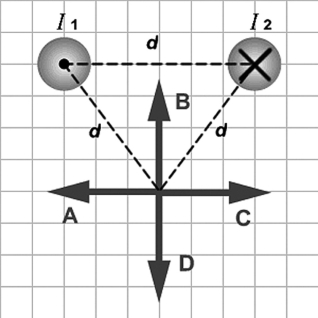
A) A
B) B
C) C
D) D
E) The magnetic field is zero at that point.

A) A
B) B
C) C
D) D
E) The magnetic field is zero at that point.
B
3
A current carrying loop of wire lies flat on a table top.When viewed from above,the current moves around the loop in a counterclockwise sense.
(a)For points OUTSIDE the loop,the magnetic field caused by this current
A)circles the loop in a clockwise direction.
B)circles the loop in a counterclockwise direction.
C)points straight up.
D)points straight down.
E)is zero.
(b)For points INSIDE the loop,the magnetic field caused by this current\
A)circles the loop in a clockwise direction.
B)circles the loop in a counterclockwise direction.
C)points straight up.
D)points straight down.
E)is zero.
(a)For points OUTSIDE the loop,the magnetic field caused by this current
A)circles the loop in a clockwise direction.
B)circles the loop in a counterclockwise direction.
C)points straight up.
D)points straight down.
E)is zero.
(b)For points INSIDE the loop,the magnetic field caused by this current\
A)circles the loop in a clockwise direction.
B)circles the loop in a counterclockwise direction.
C)points straight up.
D)points straight down.
E)is zero.
(A)D
(B)C
(B)C
4
A very long,solid,conducting cylinder of radius R carries a current along its length uniformly distributed throughout the cylinder.Which one of the graphs shown in the figure most accurately describes the magnitude B of the magnetic field produced by this current as a function of the distance r from the central axis? 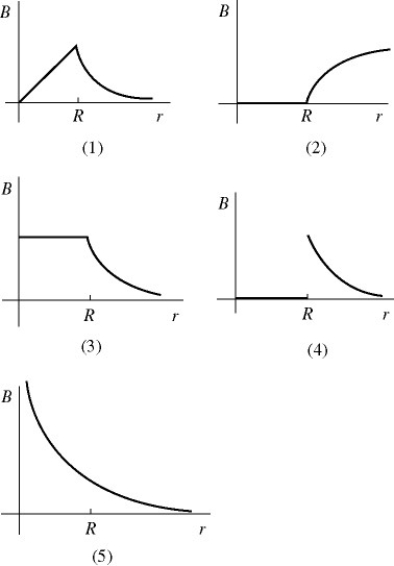
A) 1
B) 2
C) 3
D) 4
E) 5

A) 1
B) 2
C) 3
D) 4
E) 5

Unlock Deck
Unlock for access to all 52 flashcards in this deck.
Unlock Deck
k this deck
5
Two very long parallel wires in the xy-plane,a distance 2a apart,are parallel to the y-axis and carry equal currents I as shown in the figure.The +z direction points perpendicular to the xy-plane in a right-handed coordinate system.If the left current flows in the +y direction and the right current flows in the -y direction,which one of the graphs shown in the figure below best represents the z component of the net magnetic field,in the xy-plane,as a function of x? (Caution: These graphs are not magnetic field lines.) 
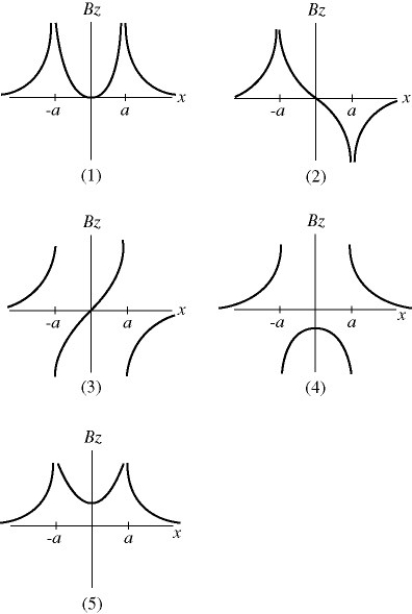
A) 1
B) 2
C) 3
D) 4
E) 5


A) 1
B) 2
C) 3
D) 4
E) 5

Unlock Deck
Unlock for access to all 52 flashcards in this deck.
Unlock Deck
k this deck
6
A long straight conductor has a constant current flowing to the right.A wire rectangle is situated above the wire,and also has a constant current flowing through it (as shown in the figure).Which of the following statements is true? 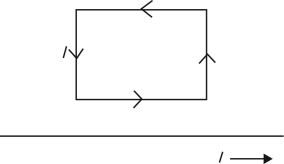
A) The net magnetic force on the wire rectangle is upward, and there is also a net torque on the it.
B) The net magnetic force on the wire rectangle is zero, and the net torque on it is zero.
C) The net magnetic force on the wire rectangle is downward, and there is also a net torque on the it.
D) The net magnetic force on the wire rectangle is zero, but there is a net torque on it.
E) The net magnetic force on the wire rectangle is downward, and the net torque on it is zero.

A) The net magnetic force on the wire rectangle is upward, and there is also a net torque on the it.
B) The net magnetic force on the wire rectangle is zero, and the net torque on it is zero.
C) The net magnetic force on the wire rectangle is downward, and there is also a net torque on the it.
D) The net magnetic force on the wire rectangle is zero, but there is a net torque on it.
E) The net magnetic force on the wire rectangle is downward, and the net torque on it is zero.

Unlock Deck
Unlock for access to all 52 flashcards in this deck.
Unlock Deck
k this deck
7
The figure shows four different sets of insulated wires that cross each other at right angles without actually making electrical contact.The magnitude of the current is the same in all the wires,and the directions of current flow are as indicated.For which (if any)configuration will the magnetic field at the center of the square formed by the wires be equal to zero? 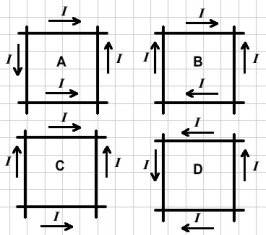
A) A
B) B
C) C
D) D
E) The field is not equal to zero in any of these cases.

A) A
B) B
C) C
D) D
E) The field is not equal to zero in any of these cases.

Unlock Deck
Unlock for access to all 52 flashcards in this deck.
Unlock Deck
k this deck
8
Two very long parallel wires in the xy-plane,a distance 2a apart,are parallel to the y-axis and carry equal currents I as shown in the figure.The +z direction points perpendicular to the xy-plane in a right-handed coordinate system.If both currents flow in the +y direction,which one of the graphs shown in the figure below best represents the z component of the net magnetic field,in the xy-plane,as a function of x? (Caution: These graphs are not magnetic field lines.) 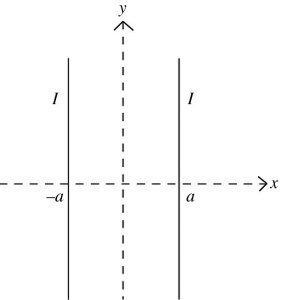
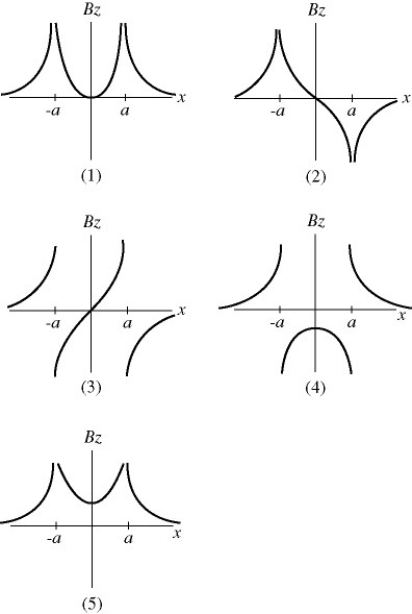
A) 1
B) 2
C) 3
D) 4
E) 5


A) 1
B) 2
C) 3
D) 4
E) 5

Unlock Deck
Unlock for access to all 52 flashcards in this deck.
Unlock Deck
k this deck
9
A point charge Q moves on the x-axis in the positive direction with a speed of  A point P is on the y-axis at
A point P is on the y-axis at  The magnetic field produced at the point P,as the charge moves through the origin,is equal to
The magnetic field produced at the point P,as the charge moves through the origin,is equal to  What is the charge Q?
What is the charge Q? 
A) -53 μC
B) +53 μC
C) -39 μC
D) +39 μC
E) +26 μC
 A point P is on the y-axis at
A point P is on the y-axis at  The magnetic field produced at the point P,as the charge moves through the origin,is equal to
The magnetic field produced at the point P,as the charge moves through the origin,is equal to  What is the charge Q?
What is the charge Q? 
A) -53 μC
B) +53 μC
C) -39 μC
D) +39 μC
E) +26 μC

Unlock Deck
Unlock for access to all 52 flashcards in this deck.
Unlock Deck
k this deck
10
Consider a solenoid of length L,N windings,and radius b (L is much longer than b).A current I is flowing through the wire.If the length of the solenoid became twice as long (2L),and all other quantities remained the same,the magnetic field inside the solenoid would
A) remain the same.
B) become twice as strong.
C) become one half as strong.
A) remain the same.
B) become twice as strong.
C) become one half as strong.

Unlock Deck
Unlock for access to all 52 flashcards in this deck.
Unlock Deck
k this deck
11
Consider a solenoid of length L,N windings,and radius b (L is much longer than b).A current I is flowing through the wire.If the radius of the solenoid were doubled (becoming 2b),and all other quantities remained the same,the magnetic field inside the solenoid would
A) remain the same.
B) become twice as strong.
C) become one half as strong.
A) remain the same.
B) become twice as strong.
C) become one half as strong.

Unlock Deck
Unlock for access to all 52 flashcards in this deck.
Unlock Deck
k this deck
12
A negatively charged particle is moving to the right,directly above a wire having a current flowing to the right,as shown in the figure.In which direction is the magnetic force exerted on the particle? 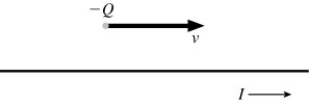
A) into the page
B) out of the page
C) downward
D) upward
E) The magnetic force is zero since the velocity is parallel to the current.

A) into the page
B) out of the page
C) downward
D) upward
E) The magnetic force is zero since the velocity is parallel to the current.

Unlock Deck
Unlock for access to all 52 flashcards in this deck.
Unlock Deck
k this deck
13
A horizontal wire carries a current straight toward you.From your point of view,the magnetic field at a point directly below the wire points
A) directly away from you.
B) to the left.
C) to the right.
D) directly toward you.
E) vertically upward.
A) directly away from you.
B) to the left.
C) to the right.
D) directly toward you.
E) vertically upward.

Unlock Deck
Unlock for access to all 52 flashcards in this deck.
Unlock Deck
k this deck
14
A very long,hollow,thin-walled conducting cylindrical shell (like a pipe)of radius R carries a current along its length uniformly distributed throughout the thin shell.Which one of the graphs shown in the figure most accurately describes the magnitude B of the magnetic field produced by this current as a function of the distance r from the central axis? 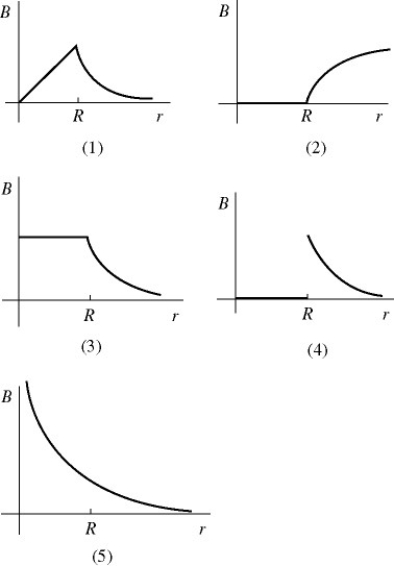
A) 1
B) 2
C) 3
D) 4
E) 5

A) 1
B) 2
C) 3
D) 4
E) 5

Unlock Deck
Unlock for access to all 52 flashcards in this deck.
Unlock Deck
k this deck
15
A vertical wire carries a current straight down.To the east of this wire,the magnetic field points
A) toward the north.
B) toward the east.
C) toward the west.
D) toward the south.
E) downward.
A) toward the north.
B) toward the east.
C) toward the west.
D) toward the south.
E) downward.

Unlock Deck
Unlock for access to all 52 flashcards in this deck.
Unlock Deck
k this deck
16
A ring with a clockwise current (as seen from above the ring)is situated with its center directly above another ring,which has a counter-clockwise current,as shown in the figure.In what direction is the net magnetic force exerted on the top ring? 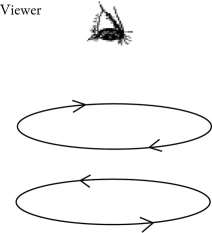
A) upward
B) downward
C) to the right
D) to the left
E) The net force is zero.

A) upward
B) downward
C) to the right
D) to the left
E) The net force is zero.

Unlock Deck
Unlock for access to all 52 flashcards in this deck.
Unlock Deck
k this deck
17
Two very long parallel wires are a distance d apart and carry equal currents in opposite directions.The locations where the net magnetic field due to these currents is equal to zero are
A) midway between the wires.
B) a distance d/2 to the left of the left wire and also a distance d/2 to the right of the right wire.
C) a distance d to the left of the left wire and also a distance d to the right of the right wire.
D) a distance d/ to the left of the left wire and also a distance d/
to the left of the left wire and also a distance d/  to the right of the right wire.
to the right of the right wire.
E) The net field is not zero anywhere.
A) midway between the wires.
B) a distance d/2 to the left of the left wire and also a distance d/2 to the right of the right wire.
C) a distance d to the left of the left wire and also a distance d to the right of the right wire.
D) a distance d/
 to the left of the left wire and also a distance d/
to the left of the left wire and also a distance d/  to the right of the right wire.
to the right of the right wire.E) The net field is not zero anywhere.

Unlock Deck
Unlock for access to all 52 flashcards in this deck.
Unlock Deck
k this deck
18
The figure shows three long,parallel,current-carrying wires.The current directions are indicated for currents I1 and I3.The arrow labeled F represents the net magnetic force acting on current I3.The three currents have equal magnitudes.What is the direction of the current I2? 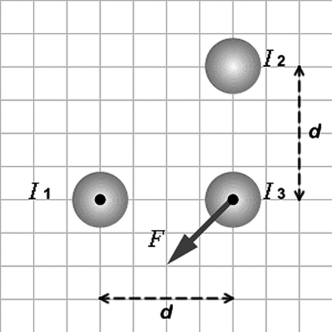
A) into the picture (in the direction opposite to that of I1 and I3)
B) horizontal to the right
C) vertically upward
D) vertically downward
E) out of the picture (in the same direction as I1 and I3)

A) into the picture (in the direction opposite to that of I1 and I3)
B) horizontal to the right
C) vertically upward
D) vertically downward
E) out of the picture (in the same direction as I1 and I3)

Unlock Deck
Unlock for access to all 52 flashcards in this deck.
Unlock Deck
k this deck
19
The figure shows three long,parallel current-carrying wires.The magnitudes of the currents are equal and their directions are indicated in the figure.Which of the arrows drawn near the wire carrying current 1 correctly indicates the direction of the magnetic force acting on that wire? 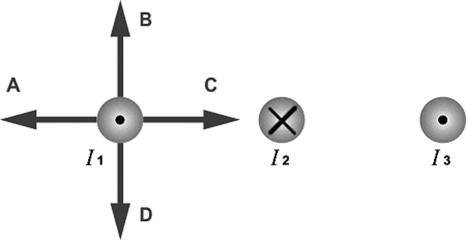
A) A
B) B
C) C
D) D
E) The magnetic force on current 1 is equal to zero.

A) A
B) B
C) C
D) D
E) The magnetic force on current 1 is equal to zero.

Unlock Deck
Unlock for access to all 52 flashcards in this deck.
Unlock Deck
k this deck
20
Two long parallel wires placed side-by-side on a horizontal table carry identical size currents in opposite directions.The wire on your right carries current toward you,and the wire on your left carries current away from you.From your point of view,the magnetic field at the point exactly midway between the two wires
A) points upward.
B) points downward.
C) points toward you.
D) points away from you.
E) is zero.
A) points upward.
B) points downward.
C) points toward you.
D) points away from you.
E) is zero.

Unlock Deck
Unlock for access to all 52 flashcards in this deck.
Unlock Deck
k this deck
21
As shown in the figure,a rectangular current loop is carrying current  = 3.0 A,in the direction shown,and is located near a long wire carrying a current
= 3.0 A,in the direction shown,and is located near a long wire carrying a current  .The long wire is parallel to the sides of the rectangle.The rectangle loop has length 0.80 m and its sides are 0.10 m and 0.70 m from the wire,as shown.We measure that the net force on the rectangular loop is
.The long wire is parallel to the sides of the rectangle.The rectangle loop has length 0.80 m and its sides are 0.10 m and 0.70 m from the wire,as shown.We measure that the net force on the rectangular loop is  and is directed towards the wire.
and is directed towards the wire. 
 (a)What is the magnitude of the current Iw?
(a)What is the magnitude of the current Iw?
(b)In which direction does Iw flow: from top to bottom or from bottom to top in the sketch?
 = 3.0 A,in the direction shown,and is located near a long wire carrying a current
= 3.0 A,in the direction shown,and is located near a long wire carrying a current  .The long wire is parallel to the sides of the rectangle.The rectangle loop has length 0.80 m and its sides are 0.10 m and 0.70 m from the wire,as shown.We measure that the net force on the rectangular loop is
.The long wire is parallel to the sides of the rectangle.The rectangle loop has length 0.80 m and its sides are 0.10 m and 0.70 m from the wire,as shown.We measure that the net force on the rectangular loop is  and is directed towards the wire.
and is directed towards the wire. 
 (a)What is the magnitude of the current Iw?
(a)What is the magnitude of the current Iw?(b)In which direction does Iw flow: from top to bottom or from bottom to top in the sketch?

Unlock Deck
Unlock for access to all 52 flashcards in this deck.
Unlock Deck
k this deck
22
At what distance from the central axis of a long straight thin wire carrying a current of 5.0 A is the magnitude of the magnetic field due to the wire equal to the strength of the Earth's magnetic field of about 5.0 × 10-5 T? (μ0 = 4π × 10-7 T ∙ m/A)
A) 1.0 cm
B) 2.0 cm
C) 3.0 cm
D) 4.0 cm
E) 5.0 cm
A) 1.0 cm
B) 2.0 cm
C) 3.0 cm
D) 4.0 cm
E) 5.0 cm

Unlock Deck
Unlock for access to all 52 flashcards in this deck.
Unlock Deck
k this deck
23
A very long thin wire produces a magnetic field of  at a distance of
at a distance of  from the central axis of the wire.What is the magnitude of the current in the wire?
from the central axis of the wire.What is the magnitude of the current in the wire? 
A) 7.5 mA
B) 1.7 mA
C) 3300 mA
D) 24,000 mA
 at a distance of
at a distance of  from the central axis of the wire.What is the magnitude of the current in the wire?
from the central axis of the wire.What is the magnitude of the current in the wire? 
A) 7.5 mA
B) 1.7 mA
C) 3300 mA
D) 24,000 mA

Unlock Deck
Unlock for access to all 52 flashcards in this deck.
Unlock Deck
k this deck
24
The figure shows two long,parallel current-carrying wires.The wires carry equal currents  A in the directions indicated and are located a distance d = 0.5 m apart.Calculate the magnitude and direction of the magnetic field at the point P that is located an equal distance d from each wire.
A in the directions indicated and are located a distance d = 0.5 m apart.Calculate the magnitude and direction of the magnetic field at the point P that is located an equal distance d from each wire. 
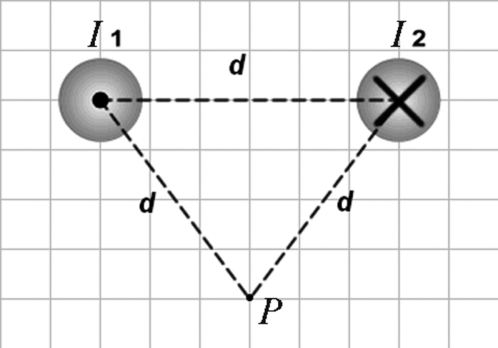
A) 8 µT downward
B) 8 µT upward
C) 4 µT downward
D) 4 µT upward
E) 4 µT to the right
 A in the directions indicated and are located a distance d = 0.5 m apart.Calculate the magnitude and direction of the magnetic field at the point P that is located an equal distance d from each wire.
A in the directions indicated and are located a distance d = 0.5 m apart.Calculate the magnitude and direction of the magnetic field at the point P that is located an equal distance d from each wire. 

A) 8 µT downward
B) 8 µT upward
C) 4 µT downward
D) 4 µT upward
E) 4 µT to the right

Unlock Deck
Unlock for access to all 52 flashcards in this deck.
Unlock Deck
k this deck
25
A wire carrying a current is shaped in the form of a circular loop of radius  If the magnetic field strength that this current produces at the center of the loop is
If the magnetic field strength that this current produces at the center of the loop is  what is the magnitude of the current that flows through the wire? (μ0 = 4π × 10-7 T • m/A)
what is the magnitude of the current that flows through the wire? (μ0 = 4π × 10-7 T • m/A)
A) 5.3 A
B) 16 A
C) 9.1 A
D) 23 A
 If the magnetic field strength that this current produces at the center of the loop is
If the magnetic field strength that this current produces at the center of the loop is  what is the magnitude of the current that flows through the wire? (μ0 = 4π × 10-7 T • m/A)
what is the magnitude of the current that flows through the wire? (μ0 = 4π × 10-7 T • m/A)A) 5.3 A
B) 16 A
C) 9.1 A
D) 23 A

Unlock Deck
Unlock for access to all 52 flashcards in this deck.
Unlock Deck
k this deck
26
As shown in the figure,a wire is bent into the shape of a tightly closed omega (Ω),with a circular loop of radius 4.0 cm and two long straight sections.The loop is in the xy-plane,with the center at the origin.The straight sections are parallel to the x-axis.The wire carries a 5.0-A current,as shown.What is the magnitude of the magnetic field at the center of the loop? (μ0 = 4π × 10-7 T • m/A) 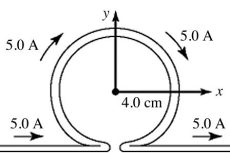
A) 25 µT
B) 40 µT
C) 54 µT
D) 80 µT
E) 104 µT

A) 25 µT
B) 40 µT
C) 54 µT
D) 80 µT
E) 104 µT

Unlock Deck
Unlock for access to all 52 flashcards in this deck.
Unlock Deck
k this deck
27
A very long straight wire carries a 12-A current eastward and a second very long straight wire carries a 14-A current westward.The wires are parallel to each other and are 42 cm apart.Calculate the force on a 6.4 m length of one of the wires.(μ0 = 4π × 10-7 T • m/A)
A) 8.0 × 10-7 N
B) 5.1 × 10-4 N
C) 8.0 × 10-5 N
D) 5.1 × 10-6 N
E) 2.2 × 10-4 N
A) 8.0 × 10-7 N
B) 5.1 × 10-4 N
C) 8.0 × 10-5 N
D) 5.1 × 10-6 N
E) 2.2 × 10-4 N

Unlock Deck
Unlock for access to all 52 flashcards in this deck.
Unlock Deck
k this deck
28
A rectangular loop of wire measures 1.0 m by 1.0 cm.If a 7.0-A current flows through the wire,what is the magnitude of the magnetic force on the centermost 1.0-cm segment of the 1.0-m side of the loop? 
A) 9.8 × 10-6 N
B) 7.8 × 10-7 N
C) 9.8 × 10-8 N
D) 4.9 × 10-6 N

A) 9.8 × 10-6 N
B) 7.8 × 10-7 N
C) 9.8 × 10-8 N
D) 4.9 × 10-6 N

Unlock Deck
Unlock for access to all 52 flashcards in this deck.
Unlock Deck
k this deck
29
A long straight wire on the z-axis carries a current of 6.0 A in the positive direction.A circular loop in the xy-plane,of radius 10 cm,carries a 1.0-A current,as shown in the figure.Point P,at the center of the loop,is 25 cm from the z-axis.An electron is projected from P with a velocity of 1.0 × 106 m/s in the negative x-direction.What is the y component of the force on the electron? (e = 1.60 × 10-19 C, 

A) -1.0 × 10-18 N
B) +1.0 × 10-18 N
C) -2.0 × 10-18 N
D) +2.0 × 10-18 N
E) zero


A) -1.0 × 10-18 N
B) +1.0 × 10-18 N
C) -2.0 × 10-18 N
D) +2.0 × 10-18 N
E) zero

Unlock Deck
Unlock for access to all 52 flashcards in this deck.
Unlock Deck
k this deck
30
As shown in the figure,an insulated wire is bent into a circular loop of radius 6.0 cm and has two long straight sections.The loop is in the xy-plane,with the center at the origin.The straight sections are parallel to the z-axis.The wire carries a current of 8.0 A.What is the magnitude of the magnetic field at the origin? (μ0 = 4π × 10-7 T • m/A) 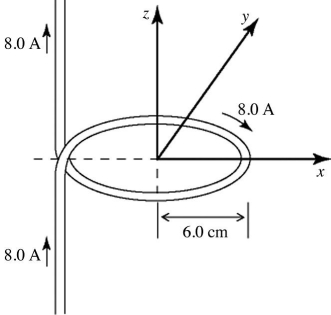
A) 75 µT
B) 81 µT
C) 88 µT
D) 110 µT
E) 120 µT

A) 75 µT
B) 81 µT
C) 88 µT
D) 110 µT
E) 120 µT

Unlock Deck
Unlock for access to all 52 flashcards in this deck.
Unlock Deck
k this deck
31
Three very long,straight,parallel wires each carry currents of 4.00 A,directed out of the page as shown in the figure.The wires pass through the vertices of a right isosceles triangle of side 2.00 cm.What is the magnitude of the magnetic field at point P at the midpoint of the hypotenuse of the triangle? 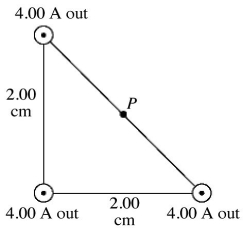
A) 4.42 × 10-6 T
B) 1.77 × 10-5 T
C) 5.66 × 10-5 T
D) 1.26 × 10-4 T
E) 1.77 × 10-6 T

A) 4.42 × 10-6 T
B) 1.77 × 10-5 T
C) 5.66 × 10-5 T
D) 1.26 × 10-4 T
E) 1.77 × 10-6 T

Unlock Deck
Unlock for access to all 52 flashcards in this deck.
Unlock Deck
k this deck
32
Two long parallel wires carry currents of 10 A in opposite directions.They are separated by 40 cm.What is the magnitude of the magnetic field in the plane of the wires at a point that is 20 cm from one wire and 60 cm from the other? (μ0 = 4π × 10-7 T • m/A)
A) 1.5 µT
B) 3.3 µT
C) 6.7 µT
D) 33 µT
E) 67 µT
A) 1.5 µT
B) 3.3 µT
C) 6.7 µT
D) 33 µT
E) 67 µT

Unlock Deck
Unlock for access to all 52 flashcards in this deck.
Unlock Deck
k this deck
33
The magnetic field at a distance of 2 cm from a current carrying wire is 4 μT.What is the magnetic field at a distance of 4 cm from the wire?
A) 1/2 µT
B) 1 µT
C) 2 µT
D) 4 µT
E) 8 µT
A) 1/2 µT
B) 1 µT
C) 2 µT
D) 4 µT
E) 8 µT

Unlock Deck
Unlock for access to all 52 flashcards in this deck.
Unlock Deck
k this deck
34
A long straight very thin wire on the y-axis carries a 10-A current in the positive y-direction.A circular loop 0.50 m in radius,also of very thin wire and lying in the yz-plane,carries a 9.0-A current,as shown.Point P is on the positive x-axis,at a distance of 0.50 m from the center of the loop.What is the magnetic field vector at point P due to these two currents? 
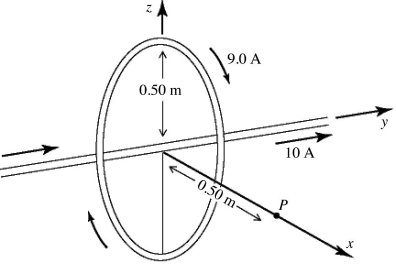
A) zero
B) -8.0 × 10-6 T
C) (+4.0 × 10-6 T) - (4.0 × 10-6 T)
- (4.0 × 10-6 T) 
D) (-4.0 × 10-6 T) - (4.0 × 10-6 T)
- (4.0 × 10-6 T) 
E) (-4.0 × 10-6 T) - (8.0 × 10-6 T)
- (8.0 × 10-6 T) 


A) zero
B) -8.0 × 10-6 T

C) (+4.0 × 10-6 T)
 - (4.0 × 10-6 T)
- (4.0 × 10-6 T) 
D) (-4.0 × 10-6 T)
 - (4.0 × 10-6 T)
- (4.0 × 10-6 T) 
E) (-4.0 × 10-6 T)
 - (8.0 × 10-6 T)
- (8.0 × 10-6 T) 

Unlock Deck
Unlock for access to all 52 flashcards in this deck.
Unlock Deck
k this deck
35
Two coaxial circular coils of radius R = 15 cm,each carrying 4.0 A in the same direction,are positioned a distance d = 20 cm apart,as shown in the figure.Calculate the magnitude of the magnetic field halfway between the coils along the line connecting their centers. 

A) 0.90 × T
T
B) 3.9 × T
T
C) 1.9 × T
T
D) 6.3 × T
T
E) 9.2 × T
T


A) 0.90 ×
 T
TB) 3.9 ×
 T
TC) 1.9 ×
 T
TD) 6.3 ×
 T
TE) 9.2 ×
 T
T
Unlock Deck
Unlock for access to all 52 flashcards in this deck.
Unlock Deck
k this deck
36
Two long parallel wires carry currents of 20 A and 5.0 A in opposite directions.The wires are separated by 0.20 m.What is the magnitude of the magnetic field midway between the two wires? 
A) 1.0 × 10-5 T
B) 2.0 × 10-5 T
C) 3.0 × 10-5 T
D) 4.0 × 10-5 T
E) 5.0 × 10-5 T

A) 1.0 × 10-5 T
B) 2.0 × 10-5 T
C) 3.0 × 10-5 T
D) 4.0 × 10-5 T
E) 5.0 × 10-5 T

Unlock Deck
Unlock for access to all 52 flashcards in this deck.
Unlock Deck
k this deck
37
A circular loop of wire of radius 10 cm carries a current of 6.0 A.What is the magnitude of the magnetic field at the center of the loop? (μ0 = 4π × 10-7 T • m/A)
A) 3.8 × 10-5 T
B) 3.8 × 10-7 T
C) 1.2 × 10-5 T
D) 1.2 × 10-7 T
E) 3.8 × 10-8 T
A) 3.8 × 10-5 T
B) 3.8 × 10-7 T
C) 1.2 × 10-5 T
D) 1.2 × 10-7 T
E) 3.8 × 10-8 T

Unlock Deck
Unlock for access to all 52 flashcards in this deck.
Unlock Deck
k this deck
38
A type of transmission line for electromagnetic waves consists of two parallel conducting plates (assumed infinite in width)separated by a distance a.Each plate carries the same uniform surface current density of 16.0 A/m,but the currents run in opposite directions.What is the magnitude of the magnetic field between the plates at a point 1.00 mm from one of the plates if a = 0.800 cm? (μ0 = 4π × 10-7 T • m/A)
A) 3.20 × 10-3 T
B) 1.00 × 10-5 T
C) 4.63 × 10-5 T
D) 2.01 × 10-5 T
E) 7.07 × 10-4 T
A) 3.20 × 10-3 T
B) 1.00 × 10-5 T
C) 4.63 × 10-5 T
D) 2.01 × 10-5 T
E) 7.07 × 10-4 T

Unlock Deck
Unlock for access to all 52 flashcards in this deck.
Unlock Deck
k this deck
39
Two circular coils of diameter 30.0 cm are parallel to each other and have their centers along the same line L but separated by 22.0 cm.When an experimenter views the coils along L,the coil closer to her carries a clockwise current of 2.50 A.Find the magnitude and sense (clockwise or counterclockwise)of the current needed in the other coil so that the net magnetic field on L midway between the two coils will have a magnitude of 4.10 µT and point away from the experimenter who is viewing the coils along L. 


Unlock Deck
Unlock for access to all 52 flashcards in this deck.
Unlock Deck
k this deck
40
As shown in the figure,two long straight wires are separated by a distance of  The currents are
The currents are  to the right in the upper wire and
to the right in the upper wire and  to the left in the lower wire.What are the magnitude and direction of the magnetic field at point P,which is a distance
to the left in the lower wire.What are the magnitude and direction of the magnetic field at point P,which is a distance  below the lower wire?
below the lower wire? 
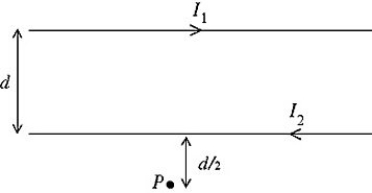
 The currents are
The currents are  to the right in the upper wire and
to the right in the upper wire and  to the left in the lower wire.What are the magnitude and direction of the magnetic field at point P,which is a distance
to the left in the lower wire.What are the magnitude and direction of the magnetic field at point P,which is a distance  below the lower wire?
below the lower wire? 


Unlock Deck
Unlock for access to all 52 flashcards in this deck.
Unlock Deck
k this deck
41
A coaxial cable consists of an inner cylindrical conductor of radius R1 = 0.040 m on the axis of an outer hollow cylindrical conductor of inner radius R2 = 0.080 m and outer radius  The inner conductor carries current
The inner conductor carries current  in one direction,and the outer conductor carries current
in one direction,and the outer conductor carries current  in the opposite direction.What is the magnitude of the magnetic field at the following distances from the central axis of the cable?
in the opposite direction.What is the magnitude of the magnetic field at the following distances from the central axis of the cable?  (a)At r = 0.060 m (in the gap midway between the two conductors)
(a)At r = 0.060 m (in the gap midway between the two conductors)
(b)At r = 0.150 m (outside the cable)
 The inner conductor carries current
The inner conductor carries current  in one direction,and the outer conductor carries current
in one direction,and the outer conductor carries current  in the opposite direction.What is the magnitude of the magnetic field at the following distances from the central axis of the cable?
in the opposite direction.What is the magnitude of the magnetic field at the following distances from the central axis of the cable?  (a)At r = 0.060 m (in the gap midway between the two conductors)
(a)At r = 0.060 m (in the gap midway between the two conductors)(b)At r = 0.150 m (outside the cable)

Unlock Deck
Unlock for access to all 52 flashcards in this deck.
Unlock Deck
k this deck
42
A toroidal solenoid has a central radius of 0.50 m and a cross-sectional diameter of 10 cm.When a current passes through the coil of the solenoid,the magnetic field inside the solenoid at its CENTER has a magnitude of 2.0 μT.What is the largest value of the magnetic field inside the solenoid when this current is flowing? (μ0 = 4π × 10-7 T • m/A)
A) 3.5 µT
B) 1.8 µT
C) 2.2 µT
D) 0.50 µT
E) 2.8 µT
A) 3.5 µT
B) 1.8 µT
C) 2.2 µT
D) 0.50 µT
E) 2.8 µT

Unlock Deck
Unlock for access to all 52 flashcards in this deck.
Unlock Deck
k this deck
43
A hollow cylinder with an inner radius of  and an outer radius of
and an outer radius of  conducts a 3.0-A current flowing parallel to the axis of the cylinder.If the current density is uniform throughout the wire,what is the magnitude of the magnetic field at a point
conducts a 3.0-A current flowing parallel to the axis of the cylinder.If the current density is uniform throughout the wire,what is the magnitude of the magnetic field at a point  from its center? (μ0 = 4π × 10-7 T • m/A)
from its center? (μ0 = 4π × 10-7 T • m/A)
A) 7.2 × 10-6 T
B) 8.0 × 10-6 T
C) 8.9 × 10-7 T
D) 7.1 × 10-8 T
 and an outer radius of
and an outer radius of  conducts a 3.0-A current flowing parallel to the axis of the cylinder.If the current density is uniform throughout the wire,what is the magnitude of the magnetic field at a point
conducts a 3.0-A current flowing parallel to the axis of the cylinder.If the current density is uniform throughout the wire,what is the magnitude of the magnetic field at a point  from its center? (μ0 = 4π × 10-7 T • m/A)
from its center? (μ0 = 4π × 10-7 T • m/A)A) 7.2 × 10-6 T
B) 8.0 × 10-6 T
C) 8.9 × 10-7 T
D) 7.1 × 10-8 T

Unlock Deck
Unlock for access to all 52 flashcards in this deck.
Unlock Deck
k this deck
44
A long,straight wire with  current flowing through it produces magnetic field strength
current flowing through it produces magnetic field strength  at its surface.If the wire has a radius R,where within the wire is the field strength equal to
at its surface.If the wire has a radius R,where within the wire is the field strength equal to  of the field strength at the surface of the wire? Assume that the current density is uniform throughout the wire.
of the field strength at the surface of the wire? Assume that the current density is uniform throughout the wire. 
A) 0.36 R
B) 0.060 R
C) 0.64 R
D) 0.030 R
 current flowing through it produces magnetic field strength
current flowing through it produces magnetic field strength  at its surface.If the wire has a radius R,where within the wire is the field strength equal to
at its surface.If the wire has a radius R,where within the wire is the field strength equal to  of the field strength at the surface of the wire? Assume that the current density is uniform throughout the wire.
of the field strength at the surface of the wire? Assume that the current density is uniform throughout the wire. 
A) 0.36 R
B) 0.060 R
C) 0.64 R
D) 0.030 R

Unlock Deck
Unlock for access to all 52 flashcards in this deck.
Unlock Deck
k this deck
45
A solenoid is wound with 970 turns on a form 4.0 cm in diameter and 50 cm long.The windings carry a current I in the sense that is shown in the figure.The current produces a magnetic field,of magnitude  near the center of the solenoid.Find the current in the solenoid windings.
near the center of the solenoid.Find the current in the solenoid windings. 
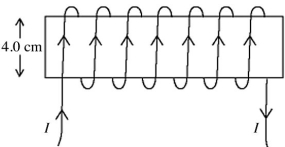
A) 1.8 A
B) 1.5 A
C) 1.3 A
D) 2.2 A
E) 2.0 A
 near the center of the solenoid.Find the current in the solenoid windings.
near the center of the solenoid.Find the current in the solenoid windings. 

A) 1.8 A
B) 1.5 A
C) 1.3 A
D) 2.2 A
E) 2.0 A

Unlock Deck
Unlock for access to all 52 flashcards in this deck.
Unlock Deck
k this deck
46
A cylindrical insulated wire of diameter 5.0 mm is tightly wound 200 times around a cylindrical core to form a solenoid with adjacent coils touching each other.When a 0.10 A current is sent through the wire,what is the magnitude of the magnetic field on the axis of the solenoid near its center? 
A) 6.6 × T
T
B) 2.5 × T
T
C) 1.3 × T
T
D) 3.6 × T
T
E) 9.8 × T
T

A) 6.6 ×
 T
TB) 2.5 ×
 T
TC) 1.3 ×
 T
TD) 3.6 ×
 T
TE) 9.8 ×
 T
T
Unlock Deck
Unlock for access to all 52 flashcards in this deck.
Unlock Deck
k this deck
47
A tube with a 3.0-mm radius has ions flowing through it along its length.To determine the rate at which the charge is being moved through the tube,the magnetic field just outside the tube is measured and found to be  If the only contributor to the magnetic field is the moving ions,and if the walls of the container are very thin and do not screen magnetism,what is the magnitude of the current flowing through the tube?
If the only contributor to the magnetic field is the moving ions,and if the walls of the container are very thin and do not screen magnetism,what is the magnitude of the current flowing through the tube? 
A) 66 A
B) 132 A
C) 829 A
D) 415 A
 If the only contributor to the magnetic field is the moving ions,and if the walls of the container are very thin and do not screen magnetism,what is the magnitude of the current flowing through the tube?
If the only contributor to the magnetic field is the moving ions,and if the walls of the container are very thin and do not screen magnetism,what is the magnitude of the current flowing through the tube? 
A) 66 A
B) 132 A
C) 829 A
D) 415 A

Unlock Deck
Unlock for access to all 52 flashcards in this deck.
Unlock Deck
k this deck
48
The figure shows the cross-section of a hollow cylinder of inner radius a = 5.0 cm and outer radius b = 7.0 cm.A uniform current density of 1.0 A/ cm2 flows through the cylinder parallel to its axis.Calculate the magnitude of the magnetic field at a distance of d = 10 cm from the axis of the cylinder. 
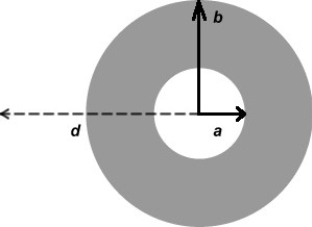
A) 0.00 T
B) 1.5 × 10-4 T
C) 2.5 × 10-4 T
D) 4.5 × 10-4 T
E) 0.50 × 10-4 T


A) 0.00 T
B) 1.5 × 10-4 T
C) 2.5 × 10-4 T
D) 4.5 × 10-4 T
E) 0.50 × 10-4 T

Unlock Deck
Unlock for access to all 52 flashcards in this deck.
Unlock Deck
k this deck
49
A 1000-turn toroidal solenoid has a central radius of 4.2 cm and is carrying a current of 1.7 A.What is the magnitude of the magnetic field inside the solenoid at the central radius? 
A) 8.1 mT
B) 51 mT
C) 16 mT
D) 81 mT
E) zero

A) 8.1 mT
B) 51 mT
C) 16 mT
D) 81 mT
E) zero

Unlock Deck
Unlock for access to all 52 flashcards in this deck.
Unlock Deck
k this deck
50
A solenoid of length 18 cm consists of closely spaced coils of wire wrapped tightly around a wooden core.The magnetic field strength is  inside the solenoid near its center when a certain current flows through the coils.If the coils of the solenoid are now pulled apart slightly,stretching it to
inside the solenoid near its center when a certain current flows through the coils.If the coils of the solenoid are now pulled apart slightly,stretching it to  without appreciably changing the size of the coils,what does the magnetic field become near the center of the solenoid when the same current flows through the coils? (μ0 = 4π × 10-7 T • m/A)
without appreciably changing the size of the coils,what does the magnetic field become near the center of the solenoid when the same current flows through the coils? (μ0 = 4π × 10-7 T • m/A)
A) 1.7 mT
B) 3.4 mT
C) 0.85 mT
D) 2.0 mT
 inside the solenoid near its center when a certain current flows through the coils.If the coils of the solenoid are now pulled apart slightly,stretching it to
inside the solenoid near its center when a certain current flows through the coils.If the coils of the solenoid are now pulled apart slightly,stretching it to  without appreciably changing the size of the coils,what does the magnetic field become near the center of the solenoid when the same current flows through the coils? (μ0 = 4π × 10-7 T • m/A)
without appreciably changing the size of the coils,what does the magnetic field become near the center of the solenoid when the same current flows through the coils? (μ0 = 4π × 10-7 T • m/A)A) 1.7 mT
B) 3.4 mT
C) 0.85 mT
D) 2.0 mT

Unlock Deck
Unlock for access to all 52 flashcards in this deck.
Unlock Deck
k this deck
51
A solenoid with 400 turns has a radius of 0.040 m and is 40 cm long.If this solenoid carries a current of  what is the magnitude of the magnetic field near the center of the solenoid?
what is the magnitude of the magnetic field near the center of the solenoid? 
A) 16 mT
B) 4.9 mT
C) 15 mT
D) 6.0 mT
E) 9.0 mT
 what is the magnitude of the magnetic field near the center of the solenoid?
what is the magnitude of the magnetic field near the center of the solenoid? 
A) 16 mT
B) 4.9 mT
C) 15 mT
D) 6.0 mT
E) 9.0 mT

Unlock Deck
Unlock for access to all 52 flashcards in this deck.
Unlock Deck
k this deck
52
A solenoid having N turns and carrying a current of 2.000 A has a length of 34.00 cm.If the magnitude of the magnetic field generated at the center of the solenoid is 9.000 mT,what is the value of N? 
A) 860.0
B) 1591
C) 2318
D) 3183
E) 1218

A) 860.0
B) 1591
C) 2318
D) 3183
E) 1218

Unlock Deck
Unlock for access to all 52 flashcards in this deck.
Unlock Deck
k this deck



